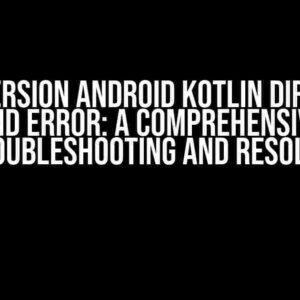Are you tired of dealing with matrix conversions in Android? Do you find yourself stuck between the world of 2D graphics and 3D OpenGL? Fear not, dear developer, for today we’re going to tackle the pesky issue of converting from android.graphics.Matrix to android.opengl.Matrix.
The Problem: Two Different Matrix Worlds
In Android, we have two distinct matrix classes: android.graphics.Matrix and android.opengl.Matrix. The former is used for 2D graphics, while the latter is used for 3D graphics with OpenGL. But what happens when you need to transport your matrix data from one world to the other? That’s where things get hairy.
Why Do I Need to Convert?
You may ask, “Why do I need to convert between these two matrices?” Well, my friend, it’s quite simple. Suppose you’re working on a project that involves both 2D and 3D graphics. Maybe you’re developing a game that uses 2D UI elements, but also features 3D models. In this case, you’ll need to convert your 2D matrix data to a format that OpenGL can understand.
Another scenario might be when you’re trying to reuse code or leverage existing libraries that rely on one matrix type, but your project requires the other. Whatever the reason, converting between android.graphics.Matrix and android.opengl.Matrix is a crucial skill to master.
Understanding the Differences
Before we dive into the conversion process, let’s take a closer look at the differences between these two matrix classes.
| Attribute | android.graphics.Matrix | android.opengl.Matrix |
|---|---|---|
| Dimension | 2D (3×3) | 3D (4×4) |
| Rotation | 2D rotation (degrees) | 3D rotation (quaternion) |
| Translation | 2D translation (x, y) | 3D translation (x, y, z) |
| Scaling | 2D scaling (x, y) | 3D scaling (x, y, z) |
As you can see, the main differences lie in the dimensionality and representation of rotation, translation, and scaling. android.graphics.Matrix is designed for 2D graphics, with a 3×3 matrix structure. On the other hand, android.opengl.Matrix is tailored for 3D graphics, featuring a 4×4 matrix structure.
Conversion Methods
Now that we understand the differences, let’s explore the methods for converting between these two matrix types.
Method 1: Manual Conversion
The first method involves manually extracting the individual components from the android.graphics.Matrix and reconstructing them into an android.opengl.Matrix.
android.graphics.Matrix graphicsMatrix = ...;
android.opengl.Matrix openglMatrix = new android.opengl.Matrix();
// Extract translation
float tx = graphicsMatrix.getTranslateX();
float ty = graphicsMatrix.getTranslateY();
// Extract rotation
float rotation = graphicsMatrix.getRotate();
// Extract scaling
float sx = graphicsMatrix.getScaleX();
float sy = graphicsMatrix.getScaleY();
// Reconstruct openglMatrix
openglMatrix.setIdentity();
openglMatrix.translate(tx, ty, 0f);
openglMatrix.rotate(rotation, 0f, 0f, 1f);
openglMatrix.scale(sx, sy, 1f);
This method is straightforward, but it can be error-prone and tedious, especially when dealing with complex matrix transformations.
Method 2: Using Matrix Inverses
The second method involves using matrix inverses to perform the conversion. This approach is more elegant and efficient, but it requires a deeper understanding of linear algebra.
android.graphics.Matrix graphicsMatrix = ...;
android.opengl.Matrix openglMatrix = new android.opengl.Matrix();
// Invert graphicsMatrix
android.graphics.Matrix invertedGraphicsMatrix = new android.graphics.Matrix();
graphicsMatrix.invert(invertedGraphicsMatrix);
// Convert to openglMatrix
float[] graphicsMatrixArray = new float[9];
invertedGraphicsMatrix.getValues(graphicsMatrixArray);
openglMatrix.setValues(new float[] {
graphicsMatrixArray[0], graphicsMatrixArray[1], 0f, 0f,
graphicsMatrixArray[2], graphicsMatrixArray[3], 0f, 0f,
0f, 0f, 1f, 0f,
graphicsMatrixArray[4], graphicsMatrixArray[5], 0f, 1f
});
In this approach, we first invert the android.graphics.Matrix, then extract its values and reorganize them into a 4×4 array compatible with android.opengl.Matrix. This method is more robust, but it requires careful attention to matrix operations and indexing.
Common Issues and Pitfalls
When converting between android.graphics.Matrix and android.opengl.Matrix, you may encounter some common issues and pitfalls. Let’s address a few of these:
- Matrix order matters: Be mindful of the order in which you perform matrix operations, as this can significantly affect the resulting transformation.
- Coordinate systems differ: android.graphics.Matrix uses a 2D coordinate system with the origin at the top-left, whereas android.opengl.Matrix uses a 3D coordinate system with the origin at the center. This can lead to unexpected results if not accounted for.
- Scaling and rotation are not commutative: When combining scaling and rotation operations, the order in which they are applied matters. Make sure to apply them in the correct order to achieve the desired transformation.
- Matrix inversion can be unstable: When using method 2, be aware that matrix inversion can be unstable for certain matrix values. This may lead to numerical instability or incorrect results.
Conclusion
In conclusion, converting from android.graphics.Matrix to android.opengl.Matrix requires a solid understanding of linear algebra and the intricacies of each matrix class. By following the methods outlined in this article, you’ll be well-equipped to handle matrix conversions with confidence.
Remember to choose the method that best suits your needs, and be mindful of the common issues and pitfalls that can arise during the conversion process. With practice and patience, you’ll master the art of matrix conversion and unlock the full potential of your Android graphics and OpenGL projects.
Bonus Tip: Matrix Libraries to the Rescue
If you find yourself frequently dealing with matrix conversions, consider utilizing a dedicated matrix library like Apache Commons Math or JAMA. These libraries provide efficient and robust implementations of matrix operations, making it easier to focus on your project’s core logic.
Frequently Asked Question
Get the answers to the most pressing questions about converting from android.graphics.Matrix to android.opengl.Matrix!
What is the main difference between android.graphics.Matrix and android.opengl.Matrix?
The main difference is that android.graphics.Matrix is used for 2D graphics and transformations in Android’s UI, while android.opengl.Matrix is used for 3D graphics and transformations in OpenGL ES. This affects the way they represent and operate on matrices.
Why can’t I simply cast android.graphics.Matrix to android.opengl.Matrix?
You can’t simply cast between the two because they have different underlying structures and uses. Android.graphics.Matrix is a 3×3 matrix, while android.opengl.Matrix is a 4×4 matrix. This means that a direct cast would lead to incorrect results and possible errors.
How do I convert an android.graphics.Matrix to an android.opengl.Matrix?
You can convert an android.graphics.Matrix to an android.opengl.Matrix by using the OpenGL ES matrix operations. You would need to extract the values from the android.graphics.Matrix and then use these values to create an android.opengl.Matrix. This can be a bit tricky, so be prepared to get your hands dirty!
What are some common issues that people face when converting between these two matrices?
Some common issues include incorrect matrix multiplication, forgetting to transpose the matrix, and incorrect handling of perspective transformations. Be careful when working with matrices, as small mistakes can lead to big problems!
Are there any libraries or tools that can help me with this conversion?
Yes, there are several libraries and tools available that can help you with this conversion. For example, you can use the Android’s OpenGL ES utility library, which provides functions for converting between different matrix types. You can also use third-party libraries like JGL or JOML, which provide more comprehensive matrix operations.


